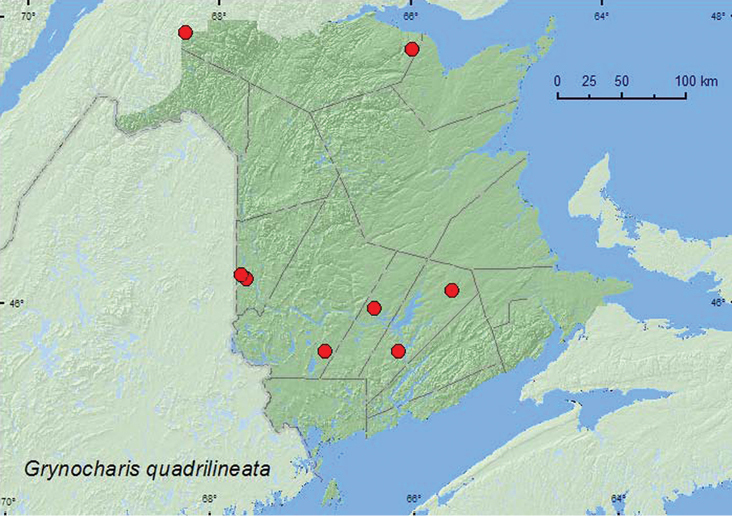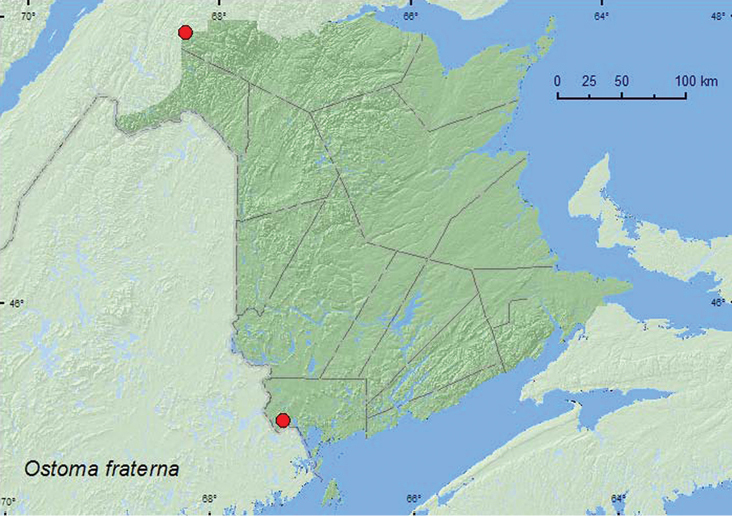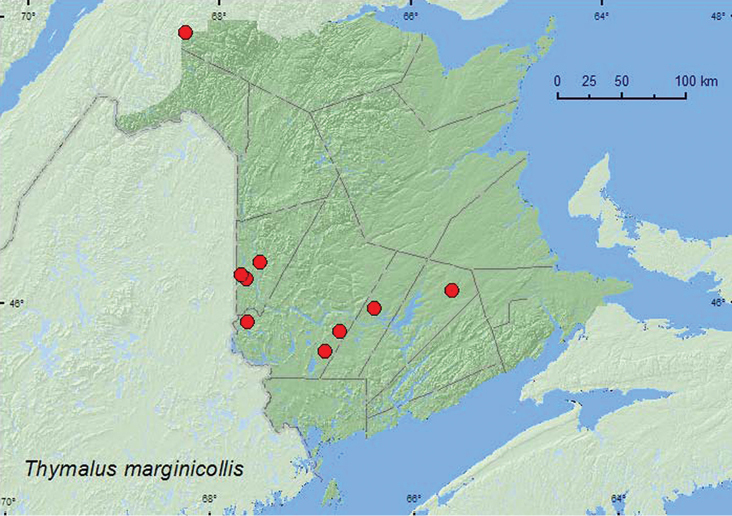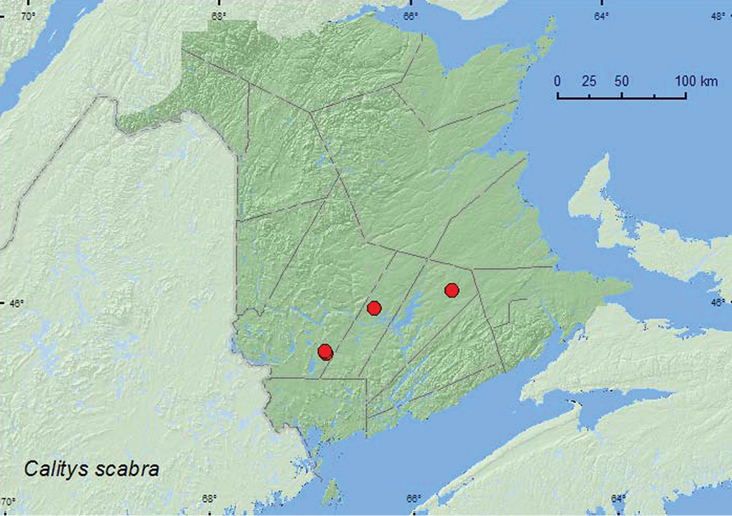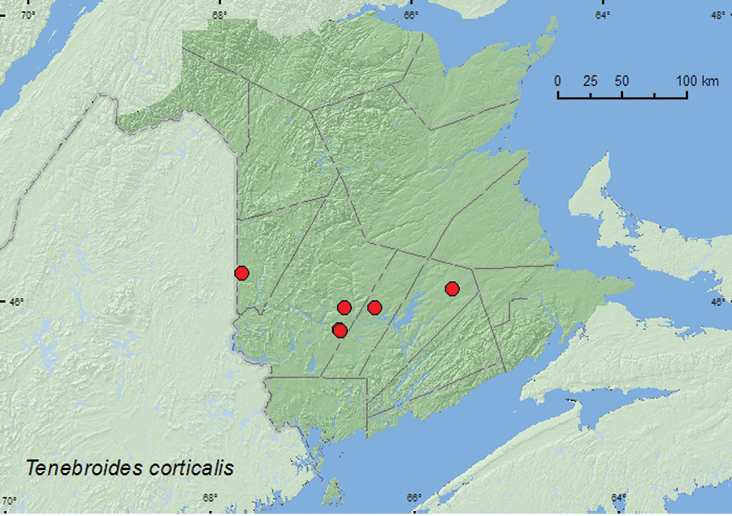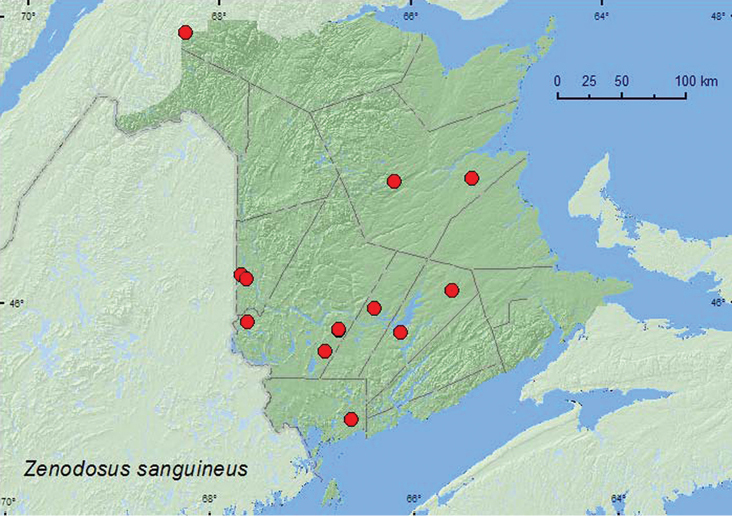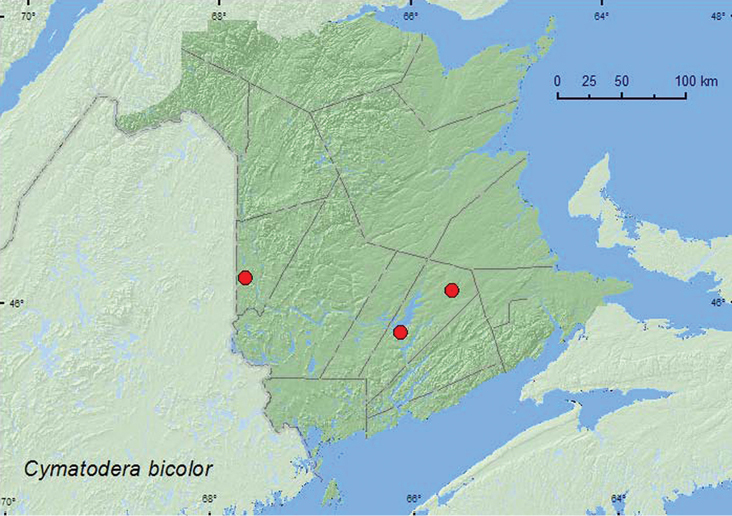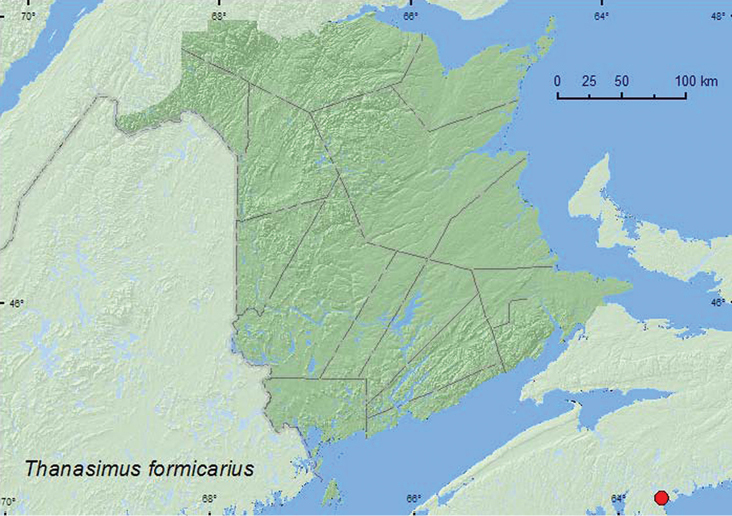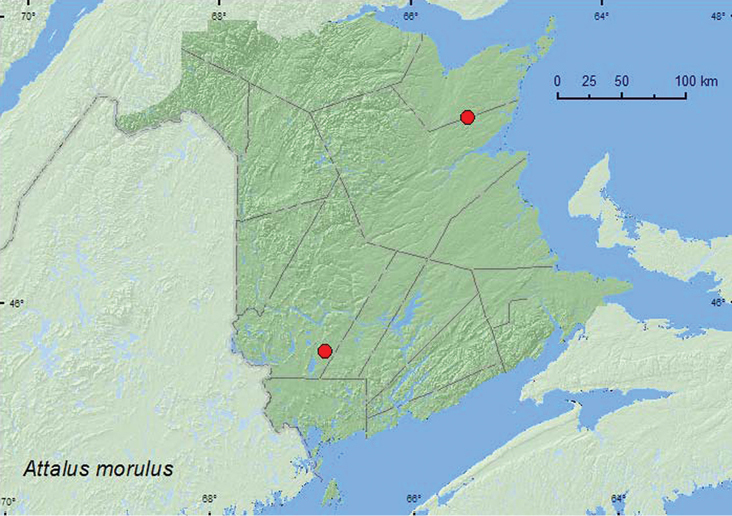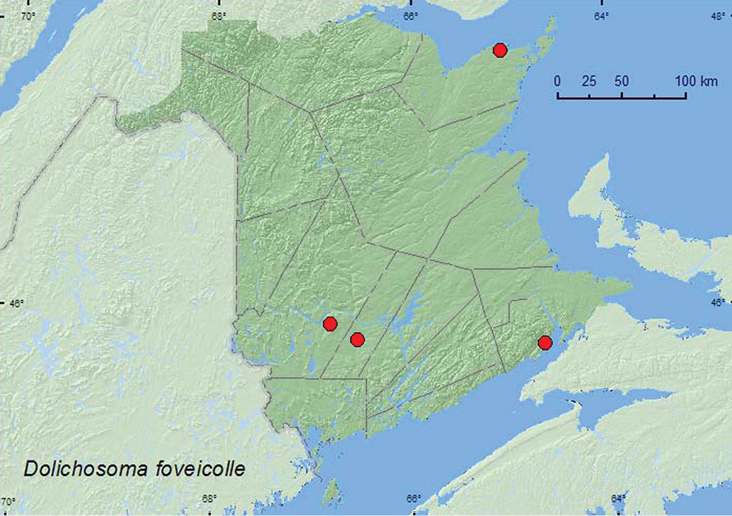






(C) 2012 Reginald P. Webster. This is an open access article distributed under the terms of the Creative Commons Attribution License 3.0 (CC-BY), which permits unrestricted use, distribution, and reproduction in any medium, provided the original author and source are credited.
For reference, use of the paginated PDF or printed version of this article is recommended.
Grynocharis quadrilineata (Melsheimer) and Tenebroides corticalis (Melsheimer) of the family Trogossitidae are newly recorded for New Brunswick, Canada. Additional records of the recently reported Calitys scabra (Thunberg)and Ostoma fraterna (Randall) are presented for the province. The record of Ostoma fraterna is the first recent record of this species from New Brunswick. Additional New Brunswick records of the thaneroclerine, Zenodosus sanguineus (Say), are given, indicting that this species is common and widespread in the province. One species of Cleridae, Cymatodera bicolor (Say), is newly reported from New Brunswick, and the adventive Thanasimus formicarius Linnaeus is newly recorded from Nova Scotia and the Maritime provinces. Attalus morulus (LeConte) and Dolichosoma foveicolle (Kirby), family Melyridae, are reported for the first time for New Brunswick and the Maritime provinces. Collection, habitat data, and distribution maps are presented for these species.
Cleridae, Melyridae, Trogossitidae, new records, Canada, New Brunswick
This paper treats new Coleoptera records from New Brunswick, Canada in the families Cleridae, Melyridae, and Trogossitidae. The fauna of these families from New Brunswick and the Maritime provinces (New Brunswick, Nova Scotia, Prince Edward Island) was recently treated by
The following records are based on specimens collected during a general survey by the first author to document the Coleoptera fauna of New Brunswick and from by-catch samples obtained during a study to develop a general attractant for Cerambycidae. Additional provincial records were obtained from specimens contained in the collection belonging to Natural Resources Canada, Canadian Forest Service - Atlantic Forestry Centre, Fredericton, New Brunswick.
Collection methodsMost specimens reported in this paper were collected from Lindgren 12-funnel trap samples during a study to develop a general attractant for the detection of invasive species of Cerambycidae. These traps may visually mimic tree trunks and are often effective for sampling species of Coleoptera that live in microhabitats associated with standing trees (
Distribution maps, created using ArcMap and ArcGIS, are presented for each species in New Brunswick, and known distribution in Canada and Alaska is listed for each. New records for New Brunswick are indicated in bold in the Distribution section. The following abbreviations are used in the text:
| AK | Alaska | MB | Manitoba |
| YT | Yukon Territory | ON | Ontario |
| NT | Northwest Territories | QC | Quebec |
| NU | Nunavut | NB | New Brunswick |
| BC | British Columbia | PE | Prince Edward Island |
| AB | Alberta | NS | Nova Scotia |
| SK | Saskatchewan | NF & LB | Newfoundland and Labrador* |
*Newfoundland and Labrador are each treated separately here.
Acronyms of collections examined or where specimens reside referred to in this study are as follows:
AFC Atlantic Forestry Centre, Natural Resources Canada, Canadian Forest Service, Fredericton, New Brunswick, Canada
CNC Canadian National Collection of Insects, Arachnids and Nematodes, Agriculture and Agri-Food Canada, Ottawa, Ontario, Canada
NBM New Brunswick Museum, Saint John, New Brunswick, Canada
RWC Reginald P. Webster Collection, Charters Settlement, New Brunswick, Canada
UMC Université de Montréal Collection, Montreal, Quebec, Canada
Results Species accountsAll records below are species newly recorded for New Brunswick, Canada, unless noted otherwise. Species followed by ** are newly recorded from the Maritime provinces of Canada.
The classification of the Cleridae follows Optitz (2010); that of the Trogossitidae and Melyridae follows
Species of Trogossitidae, Cleridae, and Melyridae recorded from New Brunswick, Canada.
| Family Trogossitidae Latreille |
| Subfamily Peltinae Latreille |
| Tribe Lophocaterini Crowson |
| Grynocharis quadrilineata (Melsheimer)* |
| Tribe Peltini Latreille |
| Ostoma fraterna (Randall) |
| Ostoma septentrionalis (Randall) |
| Tribe Thymalini Léveillé |
| Thymalus marginicollis Chevrolat |
| Subfamily Trogossitinae Latreille |
| Tribe Calityini Reitter |
| Calitys scabra (Thunberg) |
| Tribe Trogossitini Latreille |
| Tenebroides corticalis (Melsheimer)* |
| Tenebroides mauritanicus (Linnaeus) |
| Family Cleridae Latreille |
| Subfamily Thaneroclerinae Chapin |
| Tribe Zenodosini Kolibáč |
| Zenodosus sanguineus (Say) |
| Subfamily Tillinae Fischer von Waldheim |
| Cymatodera bicolor (Say)* |
| Subfamily Hydnocerinae Spinola |
| Phyllobaenus humeralis (Say) |
| Phyllobaenus lecontei (Wolcott) |
| Phyllobaenus pallipennis (Say) |
| Phyllobaenus verticalis (Say) |
| Isohydnocera curtipennis (Newman) |
| Subfamily Clerinae Latreille |
| Enoclerus muttkowskii (Wolcott) |
| Enoclerus nigripes nigripes (Say) |
| Enocleris nigripes rufiventris (Spinola) |
| Madoniella dislocata (Say) |
| Thanasimus dubius (Kirby) |
| Thanasimus undatulus (Say) |
| Trichodes nutalli (Kirby) |
| Subfamily Korynetinae Laporte |
| Necrobia violacea (Linnaeus) |
| Family Melyridae Leach |
| Subfamily Malachiinae Flemming |
| Attalus morulus (LeConte)** |
| Collops vittatus (Say) |
| Malachius aeneus (Linnaeus) |
| Nodopus flavilabris (Say) |
| Subfamily Dasytinae Laporte |
| Dolichosoma foveicolle (Kirby)** |
Notes: *New to province, **New to Maritime provinces.
Tribe Lophocaterini Crowson, 1964
http://species-id.net/wiki/Grynocharis_quadrilineata
Map 1New Brunswick, Carleton Co., Meduxnekeag Valley Nature Preserve, 46.1907°N, 67.6740°W, 20.VI.2006, R. P. Webster, mature mixed forest, in Pleurotus sp. on dead standing Populus sp. (1, NBM); same locality and forest type but 7.VI.2007, R. P. Webster, under bark of standing dead beech (4, RWC); Jackson Falls, Bell Forest, 46.2200°N, 67.7231°W, 5-12.VII.2008, R. P. Webster, mature hardwood forest, Lindgren funnel traps (2, AFC, RWC); same locality and habitat data but 23-28.IV.2009, 28.IV-9.V.2009, 14-20.V.2009, 20-26.V.2009, 16-21.VI.2009, R. Webster & M.-A. Giguère, Lindgren funnel traps (7, AFC, RWC). Queens Co., near Queenstown, 45.6904°N, 66.1455°W, 13.V.2008, R. P. Webster, old growth hardwood forest, under bark of standing dead sugar maple (1, RWC); Cranberry Lake P.N.A. (Protected Natural Area), 46.1125°N, 65.6075°W, 24.IV-5.V.2009, 5-12.V.2009, 12-21.V.2009, R. Webster & M.-A. Giguère, old red oak forest, Lindgren funnel traps (4, AFC, RWC); same locality and habitat data but, 21.V.2009, R. Webster & M.-A. Giguère, under bark of red oak (1, AFC); same locality data and forest type, 13-25.V.2011, 25.V-7.VI.2011, M. Roy & V. Webster, Lindgren funnel traps (5, AFC, NBM). Restigouche Co., Jacquet River Gorge P.N.A., 47.804°N, 65.993°W, 13-23.VI.2009, G. J. McBriarty (2, NBM); Dionne Brook P.N.A., 47.9030°N, 68.3503°W, 30.V-15.VI.2011, M. Roy & V. Webster, old-growth northern hardwood forest, Lindgren funnel traps (4, AFC, NBM). Sunbury Co., Acadia Research Forest, 45.9866°N, 66.3841°W, 19-25.V.2009, 2-9.VI.2009, 9-16.VI.2009, 24-30.VI.2009, R. Webster & M.-A. Giguère, mature (110-year-old) red spruce forest with scattered red maple and balsam fir, Lindgren funnel traps (4, AFC). York Co., 15 km W of Tracy off Rt. 645, 45.6848°N, 66.8821°W, 19-25.V.2009, 21-28.VI.2009, R. Webster & M.-A. Giguère, old red pine forest, Lindgren funnel traps (2, AFC); same locality and habitat data, 10-26.V.2010, 4-16.VI.2010, R. Webster & C. MacKay, Lindgren funnel traps (1, AFC, RWC); same locality and habitat data, 8-20.VI.2011, M. Roy & V. Webster, Lindgren funnel trap (1, NBM).
Collection localities in New Brunswick, Canada of Grynocharis quadrilineata
In New Brunswick, Grynocharis quadrilineatawas found in mature and old hardwood forests with sugar maple (Acer saccharum Marsh.) and American beech (Fagus grandifolia Ehrh.), an old-growth northern hardwood forest with sugar maple and yellow birch (Betula alleghaniensis Britt.), an old red oak (Quercus rubra L.) forest, a mature (110-year-old) red spruce (Picea rubens Sarg.) forest, and an old (180-year-old) red pine (Pinus resinosa Ait.) forest. Adults were captured in Lindgren funnel traps in most of these forest types. Specimens with microhabitat data were collected from Pleurotus mushrooms on a dead, standing poplar (Populus sp.), from under bark of a dead, standing American beech, from under bark of a standing, dead sugar maple, and from under bark of a red oak. This species has been reported from under bark of a dead poplar (
MB, ON, QC, NB, NS (
Additional New Brunswick records. Charlotte Co., St. Stephen, 17.V.1933, J. B. O’Donnel (8, AFC). Restigouche Co., Dionne Brook P.N.A., 47.9030°N, 68.3503°W, 30.V–15.VI.2011, M. Roy & V. Webster, old-growth northern hardwood forest, Lindgren funnel trap (1, RWC).
Collection localities in New Brunswick, Canada of Ostoma fraterna.
The specimen with habitat data from New Brunswick was collected from a Lindgren funnel trap deployed in an old-growth northern hardwood forest with sugar maple and yellow birch. Specimens were collected during May and June. Ostoma fraterna has been found under bark of spruce (Picea sp.) and in various Polyporaceae species (Piptoporus betulinus (Fr.) Kar., Spongiporus leucospongia (Cke. and Hark.) Murr., and Tyromyces fragilis (Fr.) Donk) (
AK, YK, NT, BC, AB, SK, ON, QC, NB, NS, NF (
Additional New Brunswick records. Carleton Co., Meduxnekeag Valley Nature Preserve, 46.1907°N, 67.6740°W, 13.VIII.2006, R. P. Webster, mature mixed forest, in polypore fungi (2, RWC); Hartland, Becaguimec Island (in Saint John River), 46.3106°N, 67.5372°W, 13.IX.2006, R. P. Webster, old mixed forest, in large dried polypore fungus (on dead standing basswood) (1, RWC); Jackson Falls, Bell Forest, 46.2200°N, 67.7231°W, 12-19.VI.2008, R. P. Webster, mature hardwood forest, Lindgren funnel trap (1, AFC); same locality and habitat data but 20-26.V.2009, 21-18.VI.2009, 31.VII-7.VIII.2009, R. Webster & M.-A. Giguère, Lindgren funnel traps (4, AFC). Queens Co., Cranberry Lake P.N.A, 46.1125°N, 65.6075°W, 18-25.VI.2009, 21-27.V.2009, 5-11.VI.2009, 11-18.VI.2009, R. Webster & M.-A. Giguère, mature red oak forest, Lindgren funnel traps (5, AFC); same locality data and forest type, 25.V-7.VI.2011, M. Roy & V. Webster, Lindgren funnel trap (1, NBM). Restigouche, Co., Dionne Brook P.N.A., 47.9030°N, 68.3503°W, 30.V-15.VI.2011, M. Roy & V. Webster, old-growth northern hardwood forest, Lindgren funnel traps (3, AFC, NBM); same locality and collectors but 47.9064°N, 68.3441°W, 15-27.VI.2011, old-growth white spruce and balsam fir forest, Lindgren funnel trap (1, NBM). Sunbury Co., Acadia Research Forest, 45.9866°N, 66.3841°W, 2-9.VI.2009, R. Webster & M.-A. Giguère, mature (110-year-old) red spruce forest with scattered red maple and balsam fir, Lindgren funnel traps (2, AFC). York Co., near Browns Mountain Fen, 45.8876°N, 67.6560°W, 3.VIII.2006, R. P. Webster, mature hardwood forest, in slightly dried Pleurotis sp. on sugar maple (4, NBM, RWC); Charters Settlement, 45.8286°N, 66.7365°W, 25.VII.2006, R. P. Webster, mixed forest, in polypore fungi on dead (standing) beech (1, RWC); 15 km W of Tracy off Rt. 645, 45.6848°N, 66.8821°W, 1-8.VI.2009, R. Webster & M.-A. Giguère, old red pine forest, Lindgren funnel traps (3, AFC).
Collection localities in New Brunswick, Canada of Thymalus marginicollis.
Thymalus marginicolliswas collected in Lindgren funnel traps in hardwood forests with sugar maple and American beech, an old-growth northern hardwood forest with sugar maple and yellow birch, an old red oak forest, mixed forests, a mature red spruce forest, and an old red pine forest. Adults were also collected from a large, dried polypore fungus on a dead, standing basswood (Tilia americana L.), in a slightly dried Pleurotus mushroom on a dead, standing sugar maple, and from a polypore fungi on a dead, standing American beech tree.
BC, AB, SK, MB, ON, QC, NB, NS, PE, NF (
Tribe Calityini Reitter, 1922
Additional New Brunswick records. Queens Co., Cranberry Lake P.N.A, 46.1125°N, 65.6075°W, 21–27.V.2009, R. Webster & M.-A. Giguère, old red oak forest, Lindgren funnel trap (1, RWC); same locality and habitat data, 25.V–7.VI.2011, 29.VI–7.VII.2011, M. Roy & V. Webster, Lindgren funnel traps (2, NBM, RWC). Sunbury Co., Acadia Research Forest, 11.VI.2008, Brawn/Harrison (2, AFC); same locality but 45.9866°N, 66.3841°W, 13–19.V.2009, 19–25.V.2009, 25.V-2.VI.2009, R. Webster & M.-A. Giguère, mature (110-year-old) red spruce forest with scattered red maple and balsam fir, Lindgren funnel traps (3, AFC, RWC). York Co., 14 km WSW of Tracy, S of Rt. 645, 45.6741°N, 66.8661°W, 10–26.V.2010, R. Webster & C. MacKay, old mixed forest with red and white spruce, red and white pine, balsam fir, eastern white cedar, red maple, and Populus sp., Lindgren funnel trap (1, RWC); 15 km W of Tracy off Rt. 645, 45.6848°N, 66.8821°W, 30.V-8.VI.2011, 8–20.VI.2011, M. Roy & V. Webster, old red pine forest, Lindgren funnel traps (6, AFC, NBM, RWC).
Collection localities in New Brunswick, Canada of Calitys scabra.
Calitys scabrawas captured in Lindgren funnel traps deployed in an old red oak forest, a mature red spruce stand, an old-growth red pine forest, and an old mixed forest. This species was reported from under bark of dead pine and from Fomitopsis pinicola (Fr.) Kar. (
AK, NT, BC, AB, MB, ON, QC, NB, NS (
New Brunswick, Carleton Co., Jackson Falls, Bell Forest, 46.2200°N, 67.7231°W, 23-28.IV.2009, 20-26.V.2009, 8-16.VI.2009, R. P. Webster & M.-A. Giguère, mature hardwood forest, Lindgren funnel traps (4, AFC, RWC). Queens Co., Cranberry Lake P.N.A, 46.1125°N, 65.6075°W, 24.IV-5.V.2009, 5-12.V.2009, 12-21.V.2009, 21-27.V.2009, R. Webster & M.-A. Giguère, old red oak forest, Lindgren funnel traps (11, AFC, RWC); same locality data and forest type, 13-25.V.2011, 25.V-7.VI.2011, M. Roy & V. Webster, Lindgren funnel traps (3, NBM). Sunbury Co., Acadia Research Forest, 45.9866°N, 66.3841°W, 16-24.VI.2009, 24-30.VI.2009, 13-21.VII.2009, R. Webster & M.-A. Giguère, mature (110- year-old) red spruce forest with scattered red maple and balsam fir, Lindgren funnel traps (4, AFC). York Co., Charters Settlement, 45.8340°N, 66.7450°W, 2.IV.2005, R. P. Webster, mixed forest, in moss and lichens on tree trunk (1, RWC); same locality and collector but 45.8267°N, 66.7343°W, 16.IV.2005, Carex marsh, in litter and sphagnum at base of tree (1, RWC); Nashwaaksis River at Rt. 105, 45.9850°N, 66.6900°W, 6.V.2006, R. P. Webster, river margin in flood debris on upper river margin (1, RWC).
Collection localities in New Brunswick, Canada of Tenebroides corticalis.
Tenebroides corticalis was captured in Lindgren funnel traps deployed in both deciduous and coniferous forests in New Brunswick. These included a mature hardwood forest with sugar maple, American beech, and white ash (Fraxinus americana L.), an old red oak forest, a mixed forest, and a mature red spruce forest. Adults were also collected from moss and lichens on a tree trunk, in litter and sphagnum at the base of a tree in a Carex marsh, and in flood debris on the upper margin of a river.
AK, YK, NT, BC, SK, MB, ON, QC, NB, NS (
The Cleridae (the checkered beetles) prey on other insects as larvae and adults (
Additional New Brunswick records. Carleton Co., Jackson Falls, Bell Forest, 46.2200°N, 67.7231°W, 13.VIII.2006, R. P. Webster, hardwood forest, in decaying fleshy polypore fungi (1, RWC); same locality data, collector, and forest type, 6.V.2007, in partially dried polypore fungus on dead tree (1, RWC); same locality data, collector, and forest type, 4-12.VI.2008, Lindgren funnel trap (1, AFC); same locality and forest type but 23-28.IV.2009, R. P. Webster & M.-A. Giguère, mature hardwood forest, Lindgren funnel traps (4, AFC); Meduxnekeag Valley Nature Preserve, 46.1900°N, 67.6700°W, 7.VI.2007, R. P. Webster, hardwood forest, under bark of standing dead beech (1, RWC). Charlotte Co., 10 km NW of New River Beach, 45.2110°N, 66.6170°W, 15-29.VI.2010, R. Webster & C. MacKay, old growth eastern white cedar forest, Lindgren funnel trap (1, RWC). Northumberland Co., 12.0 km SSE of Upper Napan near Goodfellow Brook, 46.8943°N, 65.3810°W, 23.V.2007, R. P. Webster, recent clearcut, under bark of spruce log (1, RWC). Queens Co., Grand Lake near Scotchtown, 46.8762°N, 66.1816°W, 30.IV.2006, R. P. Webster, oak forest, under bark of oak (1, RWC); same locality data, collector, and forest type, 19.IX.2006, in decayed log covered with gilled mushrooms and polypore fungi (1, RWC); Cranberry Lake P.N.A, 46.1125°N, 65.6075°W, 24.IV-5.V.2009, 12-21.V.2009, R. Webster & M.-A. Giguère, old red oak forest, Lindgren funnel traps (5, AFC); Grand Lake Meadows P.N.A., 45.8227°N, 66.1209°W, 4-19.V.2010, 19-31.V.2010, R. Webster, C. MacKay, M. Laity, & R. Johns, old silver maple forest with green ash and seasonally flooded marsh, Lindgren funnel traps (2, AFC). Restigouche, Co., Dionne Brook P.N.A., 47.9030°N, 68.3503°W, 31.V-15.VI.2011, M. Roy & V. Webster, old-growth northern hardwood forest, Lindgren funnel traps (3, AFC, NBM); same locality and collectors but 30.V-15.VI.2011, old-growth white spruce and balsam fir forest, Lindgren funnel traps (4, AFC, NBM). Sunbury Co., Acadia Research Forest, 45.9866°N, 66.3841°W, 13-19.V.2009, R. Webster & M.-A. Giguère, mature (110-year-old) red spruce forest with scattered red maple and balsam fir, Lindgren funnel traps (3, AFC). York Co., Charters Settlement, 45.8340°N, 66.7450°W, 20.V.2007, R. P. Webster, mature mixed forest, in polypore fungi on Populus log (1, RWC); Canterbury near Browns Mtn. Fen, 45.8876°N, 67.6560°W, 3.VIII.2006, R. P. Webster, hardwood forest, on slightly dried Pleurotus sp. on sugar maple (1, RWC); 15 km W of Tracy off Rt. 645, 45.6848°N, 66.8821°W, 25.IV-4.V.2009, 25.V-1.VI.2009, 1-8.VI.2009, 15-21.VI.2009, R. Webster & M.-A. Giguère, old red pine forest, Lindgren funnel traps (4, AFC); Charters Settlement, 45.8395°N, 66.7391°W, 1-5.VI.2011, R. P. Webster, mixed forest, flight intercept trap (1, NBM).
Collection localities in New Brunswick, Canada of Zenodosus sanguineus.
In New Brunswick, this species was captured in Lindgren funnel traps deployed in various deciduous and coniferous forest types. These included a mature hardwood forest, an old red oak forest, an old silver maple (Acer saccharinum L.) forest, an old-growth northern hardwood forest, a mature mixed forest, an old red pine forest, a mature red spruce forest, an old-growth eastern white cedar forest, and an old-growth white spruce (Picea glauca (Moench) Voss) and balsam fir (Abies balsamea (L.) Mill.) forest. Adults with micro-habitat data were collected from decaying fleshy polypore fungi and a partially dried polypore fungus on dead, standing trees, in a decayed log covered with gilled mushrooms and polypore fungi, on a slightly dried Pleurotus sp. on a sugar maple, in a polypore fungi on a Populus log, under bark of a dead, standing American beech tree, and under bark of a spruce and a red oak log. Adults were collected during April, May, June, August, and September.
ON, QC, NB, NS, PE (
New Brunswick, Carleton Co., Meduxnekeag Valley Nature Preserve, 46.1957°N, 67.6803°W, 10.VI.2005, R. P. Webster, mixed forest, u.v. light trap (1, RWC). Queens Co., Cranberry Lake P.N.A, 46.1125°N, 65.6075°W, 29.VI-7.VII.2011, 20.VII-4.VIII.2011, M. Roy & V. Webster, old red oak forest, Lindgren funnel traps in forest canopy (8, AFC, NBM, RWC); Grand Lake Meadows P.N.A., 45.8227°N, 66.1209°W, 21.VI-5.VII.2011, M Roy & V. Webster, old silver maple forest and seasonally flooded marsh, Lindgren funnel trap in forest canopy (1, RWC).
Collection localities in New Brunswick, Canada of Cymatodera bicolor.
One specimen from New Brunswick was captured in an ultraviolet light trap in a mixed forest area. Others were captured in Lindgren funnel traps deployed in the canopy of red oaks in an old red oak forest and in the canopy of a silver maple in a silver maple forest. Adults were captured during June, July, and August.
ON, QC, NB, NS (
Nova Scotia, Halifax Co., (Halifax) Point Pleasant Park, 44.6226°N, 63.5689°W, 11.VII.2001, 8.VIII.2001, J. Sweeney, Lindgren funnel traps, tree blend lure (2, AFC, CNC). Quebec, Berthierville, late 1940’s, Frère Adrien Robert (UMC).
Collection localities in Nova Scotia, Canada of Thanasimus formicarius.
In Europe, Thanasimus formicarius is a well-known predator of bark beetles (
QC, NS. This old-world species was introduced into North America to control the bark beetle, Dendroctonus frontalis Zimmermann in 1892 and in the late 1900s (
New Brunswick, Northumberland Co., Blueberry Rd., off Hwy 8, 47.3210°N, 65.4229°W, 24.VII.2005, R. P. Webster, jack pine forest, on foliage of jack pine (1, RWC). York Co., 15 km W of Tracy off Rt. 645, 45.6848°N, 66.8821°W, 29.VII–4.VIII.2009, R. Webster & M.-A. Giguère, old red pine forest, Lindgren funnel trap (1, RWC); same locality data and forest type, 13–27.VII.2010, R. Webster & C. MacKay, Lindgren funnel traps (2, AFC, RWC).
Collection localities in New Brunswick, Canada of Attalus morulus.
Attalus morulus were captured in Lindgren funnel traps deployed in an old-growth red pine forest. One individual was collected from foliage of jack pine (Pinus banksiana Lamb.) in a jack pine forest. Adults were captured during July and August.
BC, QC, NB (
New Brunswick, Albert Co., Shepody N.W.A., Mary’s Point Section, 45.7320°N, 64.6765°W, 16.VI.2004, R. P. Webster, margin of salt marsh near forest, sweeping (1, RWC). Gloucester Co., near Acadian Historical Village, 47.7873°N, 65.0756°W, 29.VI.2006, R. P. Webster, inland margin of salt marsh, sweeping vegetation (6, NBM, RWC). Sunbury Co., Burton, near Sunpoke Lake, 45.7662°N, 66.5526°W, 20.VI.2007, R. P. Webster, seasonally flooded marsh, sweeping vegetation (1, RWC). York Co., Mazerolle Settlement, 45.8765°N, 66.8260°W, 8.VI.2008, R. P. Webster, beaver meadow, sweeping vegetation along brook margin (2, RWC).
Collection localities in New Brunswick, Canada of Dolichosoma foveicolle
Adults were found in June on the inner margin of salt marshes, seasonally flooded (freshwater) marshes, and in a beaver meadow, and were collected by sweeping the marsh vegetation.
BC, AB, MB, ON, QC, NB, (
We thank Caroline Simpson for editing this manuscript and Serge Laplante (Agriculture and Agri-Food Canada (CNC), Ottawa) for determining specimens and other assistance. Two anonymous reviewers are thanked for their comments that improved the manuscript. Nichole Brawn, Katie Burgess, Marie-Andrée Giguère, Nancy Harn, Cory Hughes, Rob Johns, Marsell Laity, Colin MacKay, Wayne MacKay, Jessica Price, Michelle Roy, D. Sabine, and Vincent Webster are thanked for technical assistance and collecting specimens; Natural Resources Canada - Canadian Forest Service, the Canadian Food Inspection Agency, and the USDA APHIS for funding the study on early detection of invasive cerambycids, which provided many specimens collected in Lindgren funnel traps; the Canadian Wildlife Service for funding insect surveys at the Shepody National Wildlife Areas; the New Brunswick Environmental Trust Fund and New Brunswick Wildlife Trust Fund for funding various insect surveys over the past 7 years; and the Meduxnekeag River Association for permission to sample beetles at the Meduxnekeag Valley Nature Preserve (which includes the Bell Forest). The New Brunswick Department of Natural Resources (Fish and Wildlife Branch) is thanked for issuing permits for sampling in the Protected Natural Areas and for providing logistical support. Survey work in the Jacquet River Gorge Protected Natural Area was organized through the New Brunswick Museum, with external funding from the New Brunswick Environmental Trust Fund, Salamander Foundation, and the New Brunswick Wildlife Trust Fund.
